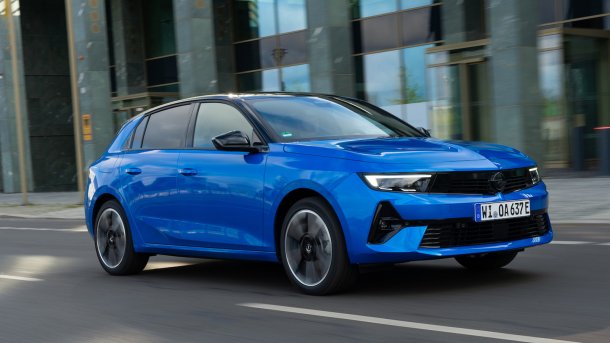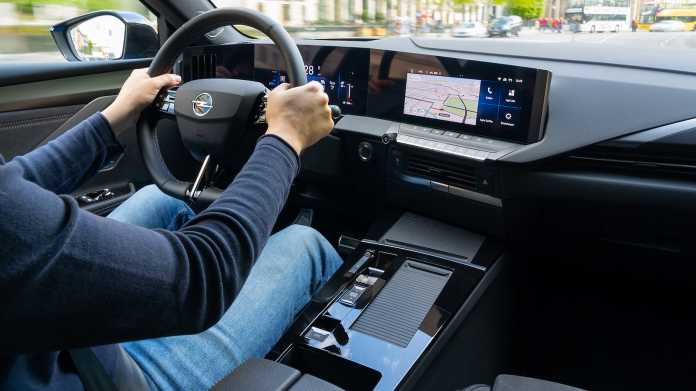Opel Astra Electric driving report: Expensive electric car, conventional package
Opel is not placing the Astra as an electric car on its own platform. What does that mean for customers in everyday life? A first test drive.

Electric car, conventionally packaged: Those who don't like brash, futuristic design will like the Astra.
(Bild: Opel)
- Joaquim Oliveira
- Martin Franz
(Hier finden Sie die deutsche Version des Beitrags)
Many manufacturers strictly separate the new and old worlds. Groups such as Hyundai and Volkswagen are now placing electric cars on their own platforms. BMW and Opel are taking a different approach. Here, all the drives on offer are available under one shell. This saves costs because the manufacturer does not have to maintain two parallel structures. On the other hand, it deprives them of the freedom in design that the switch to battery electric drive opens up. This is also evident in the Astra Electric, which was available to us for an initial test drive.
Scarce space
At 4.37 m, the Astra is around 11 cm longer than a VW ID.3, but the space available is noticeably smaller. There is less legroom in the back seat in particular. As a combustion engine, the Astra offers 422 liters of trunk space; in the electric car it is only 352 liters. Higher demands are to be met by the station wagon, which will be added in the fall. The Astra Electric resembles the models with combustion engines not only on the outside, but also in the interior. That's good news because, as usual, it's neatly finished and doesn't expect its users to have any special curls when it comes to operating it. Everything that is often needed in everyday life is either directly accessible or can be pulled close to the surface in the infotainment system - a model that should set an example. If Opel continues to work on voice control, there will be little to complain about here.
Chassis: A successful compromise
At 1679, the Astra Electric is just under 140 kg lighter than a VW ID.3 with a 58-kWh battery. This may contribute to the fact that it seems quite agile on the road without getting bogged down in comfort. Opel has found a successful compromise between driving stability and filtering bumps. It also seems very stable during quick load changes. Although the steering feels rather light in normal mode, the driver has good and direct feedback from the road. In the Astra with plug-in hybrid, we had criticized the brake response. This is also better in the electric car, and the transition between recuperation and service braking is smooth. Recuperation can be adjusted in two stages: Normally, it decelerates with up to 15 kW, in B mode it is a maximum of 45 kW. What is missing is a glide mode without recuperation.
Opel Astra Electric (5 Bilder)

Low consumption
Opel states values between 14.8 and 15.5 kWh/100 km in the WLTP, which includes charging losses. That seems quite achievable, at least the on-board computer, which does not take charging losses into account, indicated values of just under 13 kWh/100 km during our drive completed at a moderate speed. That is more than respectable; the Corsa-e is not much lower under similar conditions. Averaged over the year, the Astra Electric will probably be well above the values read during this drive.
DC charging power and battery
The battery capacity is stated at 54 kWh, which should be enough for a range of between 398 and 418 km in the WLTP. On the highway, it is more likely to be 300 km. However, the Astra is not an ideal touring car for long distances anyway. Opel states a maximum DC charging power of 100 kW. In this respect, nothing has changed with the update of the electric powertrain last year. Opel specifies a duration of 26 minutes for refilling the 60 percent between 20 and 80 percent charge level. In an interview with Autobild, Opel CEO Florian Huettl hints at progress on this issue without, admittedly, being specific. In the long term, Stellantis will also have no choice, because with a charging power of 100 kW, the Astra is already at the lower end of what has become normal. At least: the charger for alternating current is three-phase as standard in the Astra. In the Corsa, this acceleration costs over 1000 euros extra. There is currently no talk of AC charging at 22 kW or bidirectional charging at Stellantis.
Opel also remains comparatively restrained in terms of engine output. The Astra Electric has 115 kW. The big boost that some electric cars have is missing here, but the compact car is of course still fast. It accelerates smoothly at all times and thus appears pleasantly agile. Up to 170 km/h is said to be possible on the highway. It can be said that the Astra is very quiet at around 130 km/h.
(Bild: Opel)
Astra Electric: No bargain
At launch, the Astra Electric is only available in the sporty GS trim. Included are, among other things, the comfortable heated sports seats, a parking aid with 360-degree panoramic view, 18-inch Alus and the heat pump. Opel wants additional money for things like navigation system, matrix light or various assistants. Even the base price of 45,060 euros speaks for a courageous self-confidence. The Astra is undoubtedly well insulated, neatly finished, cleverly tuned, more than adequately nippy and easy to operate - all in all, a car that is a pleasure to drive. However, it is not a front-runner when it comes to charging performance and energy content in the battery. Opel will have to improve this or see how the market readjusts the real price.
(mfz)